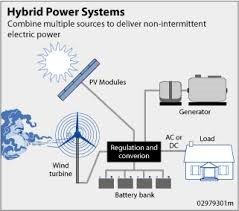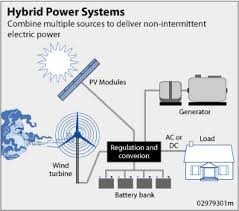Hybrid energy systems (HRES) are becoming a viable alternative for home power generation applications. Due to advances in renewable energy technologies energy production from solar cells, wind turbines and geothermal systems are being commonly used in homes and rural areas. Prices for petroleum based carbon fuels will definitely rise making the green technology a more attractive solution.

Hybrid energy offers an alternative to the electric grid
A hybrid energy system usually consists of a combination of solar and wind sources with a control unit to monitor power production and consumption. Geothermal systems are becoming more popular and generator backup systems are an emergency standby. Battery banks for power storage are an alternative for power usage during slow energy production and these systems commonly use a computerized power allocation control unit to optimize energy consumption. As the world consumes more and more power, particularly in developing nations, the demand for a sustainable power supply will continue to drive prices to levels that make alternative power sources more convenient and practical. Home Hybrid Energy is a source for up to date information and access to cutting edge technology for home hybrid energy needs. Check out our latest info about the different ways to bring alternative energy into your home.

When you talk to people about going off grid most of the questions they ask are about solar power. Everyone wants to know how much it costs and how do you figure out what size system to put in? How many panels? Are you going to have batteries and if so how many? Oh and how much does it cost?
If you are thinking of going off grid you are going to ask the same questions and it doesn’t matter whether you are going to have solar power, a wind turbine, or a water powered hydro generator. In order to size any of the above systems you are first going to have to calculate your electrical needs. Until you do that you can’t have an intelligent conversation about what type of system, or what size system you are going to need, or how much it is going to cost.
There are whole books written on this subject so I am just going to share the actual steps we took to figure out what our power needs would be.
The first thing I did was read the book Solar Power for Dummies. I’m not kidding. What did I know about off grid power systems? One book led to another and there was a fair amount of time spent on the Internet researching as well.
In all the research, one simple tool stood out time and again in slightly different formats but similar in nature and practical use. It was a chart which listed all of your typical electrical appliances with their associated wattage and how much time you used each appliance each day. A sample is worth 1000 words so you can click here to see it. I created this one on Excel so that I could enter the formulas to make it automatically calculate the watts per day. On this spreadsheet all you have to do is write down the appliance and figure out how long it will run each day and how many watts it uses.
Some of our appliances only listed amps not watts and there is a simple conversion formula for that too. Watts = Volts X Amps. If your stereo is rated at 3 amps and you plug it into an 110v wall outlet then just multiply 3 x 110 = 330 watts! You will find most watts or amp ratings somewhere on the appliance tag. If not, look up the appliance online and pull up the specification sheet or just use something similar. Remember this is an estimate and not an exact accounting.
When we were done our Spreadsheet looked like this. Now we had something to talk about. This was the starting point to research what kind of system and how large a power system we would need. Your daily electrical use will determine the size of the system. We knew we needed something that produced at least 6 kWh per day in order to meet our needs
If we were going to go with solar power this information would tell us how large an inverter, how many solar panels, and how large a battery bank would be needed. If we went with wind turbines it would tell us how large a turbine and also the inverter and batteries for that system. The same would apply to hydro.
Notice that what appliances you decide to go with affect this chart. You can see right away you had better switch from an electrical stove and oven to propane or gas or wood. By creating this chart, this is where you start making lifestyle decisions about how you are going to live, where you are going to live, and what you are going to use to live.
It’s a very exciting exercise because you get to choose where to draw the line in every category of living – food, water, and shelter. We made a lot of choices that were different than the way we had been doing things and it made us feel really good to know we were doing a better job for us, our family, and the environment and the best part is, we didn’t have to give up anything to do it. We just made better choices.
Check out this DIY Hybrid system here!




No Comments Yet